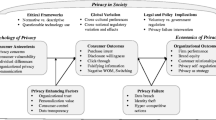Abstract
This paper considers the external validity of the growing corpus of literature that reports the use of laboratory auctions to reveal consumers’ willingness to pay for consumer goods, when the concerned goods are sold in retail stores through posted price procedures. The quality of the parallel between the field and the lab crucially depends on whether being informed of the actual field price influences a consumer’s willingness to pay for a good or not. We show that the elasticity of the WTP revision according to the field price estimation error is significant, positive, and can be roughly approximate to one quarter of the error. We then discuss the normative implications of these results for future experiments aimed at eliciting private valuations through auctions.
Similar content being viewed by others
References
Becker, G. M., DeGroot, M. H., & Marschak, J. (1964). Measuring utility by a single-response sequential method. Behavioral Science, 9, 226–232.
Brookshire, D. S., Coursey, D. L., & Schulze, W. D. (1987). The external validity of experimental economics techniques: analysis of demand behavior. Economic Inquiry, 25(2), 239–250.
Buzby, J. C., Fox, J. A., Ready, R. C., & Crutchfield, S. R. (1998). Measuring consumer benefits of food safety risk reductions. Journal of Agricultural and Applied Economics, 30(1), 69–82.
Carlsson, F., Frykblom, P., & Lagerkvist, C. J. (2007). Preferences with and without prices—does the price attribute affect behavior in stated preference surveys? Environmental and Resource Economics, 38, 155–164.
Cason, T. N., Friedman, D., & Milam, G. H. (2003). Bargaining versus posted price competition in customer markets. International Journal of Industrial Organization, 21(2), 223–251.
Cherry, T. L., Frykblom, P., Shogren, J. F., List, J. A., & Sullivan, M. B. (2004). Laboratory testbeds and non-market valuation: the case of bidding behavior in a second-price auction with an outside option. Environmental & Resource Economics, 29, 285–294.
Corrigan, J. R., & Rousu, M. C. (2006). Posted prices and bid affiliation: evidence from experimental auctions. American Journal of Agricultural Economics, 88(4), 1078–1090.
Cummings, R. G., Elliot, S., Harrison, G. W., & Rutstrom, E. E. (1995). Homegrown values and hypothetical surveys: is the dichotomous choice approach incentive-compatible? The American Economic Review, 85(1), 260–266.
Drichoutis, A. C., Lazaridis, P., & Nayga, R. M. Jr. (2008). The role of reference prices in experimental auctions. Economics Letters, 99, 446–448.
Fox, J. A. (1995). Determinants of consumer acceptability of bovine somatotropin. Review of Agricultural Economics, 17, 51–62.
Harrison, G. W., Harstad, R. M., & Rutström, E. E. (2004). Experimental methods and elicitation of values. Experimental Economics, 7, 123–140.
Hayes, D. J., Shogren, J. F., Shin, S. U., & Kliebenstein, J. B. (1995). Valuing food safety in experimental auction markets. American Journal of Agricultural Economics, 77, 40–53.
Hoffman, E., Menkhaus, D. J., Chakravarti, D., Field, R. A., & Whipple, G. D. (1993). Using laboratory experimental auctions in marketing research: a case study of new packaging for fresh beef. Marketing Science, 12(3), 318–338.
Issanchou, S., Ginon, E., & Combris, P. (2008). How preferences drive consumers’ behaviour? Conference: analyse des choix alimentaires et méthodes expérimentales, Pôle de l’Alimentation Parisien.
Krishna, V. (2010). Auction theory. San Diego: Academic Press.
List, J. (2003). Using random nth price auctions to value non-market goods and services. Journal of Regulatory Economics, 23(2), 193–205.
List, J., & Shogren, J. (1998). Experimental calibration of the difference between actual and hypothetical reported valuations. Journal of Economic Behavior and Organization, 37(2), 193–205.
Lusk, J. L., & Norwood, F. B. (2008). A calibrated auction-conjoint valuation method: valuing pork and eggs produced under differing animal welfare conditions. Working Paper.
Lusk, J. L., & Shogren, J. F. (2007). Experimental auctions, methods and applications in economic and marketing research, quantative methods for applied economics and business research series. Cambridge: Cambridge University Press.
Lusk, J. L., Daniel, M. S., Mark, D. R., & Lusk, C. L. (2001). Alternative calibration and auction institutions for predicting consumer willingness to pay for nongenetically modified corn chips. Journal of Agricultural and Resource Economics, 26(1), 40–57.
Noussair, C., Robin, S., & Ruffieux, B. (2004a). Do consumers really refuse to buy genetically modified food? Economic Journal, 114, 102–120.
Noussair, C., Robin, S., & Ruffieux, B. (2004b). Revealing consumers’ willingness-to-pay: a comparison of the BDM mechanism and the Vickrey auction. Journal of Economic Psychology, 25(6), 725–741.
Neill, H. R., Cummings, R. G., Ganderton, P. T., Harrison, G. W., & McGuckin, T. (1994). Hypothetical surveys and real economic commitments. Land Economics, 70(2), 145–154.
Roosen, J., Fox, J. A., Hennessy, D. A., & Schreiber, A. (1998). Consumers’ valuation of insecticide use restrictions: an application to apples. Journal of Agricultural and Resource Economics, 23(2), 367–384.
Rousu, M. C., & Corrigan, J. R. (2008). Estimating the welfare loss to consumers when food labels do not adequately inform: an application to fair trade certification. Journal of Agricultural & Food Industrial Organization, 6(1).
Smith, V. (1976). Experimental economics: induced value theory. The American Economic Review, 66(2), 274–279.
Rutström, E. E. (1998). Home-grown values and incentive compatible auction design. International Journal of Game Theory, 27, 427–441.
Vickrey, W. (1961). Counterspeculation, auctions, and competitive sealed tenders. Journal of Finance, 16, 8–37.
Wertenbroch, K., & Skiera, B. (2002). Measuring consumers’ willingness to pay at the point of purchase. Journal of Marketing Research, 39, 228–241.
Zhao, J., & Kling, C. (2004). Willingness to pay, compensating variation, and the cost of commitment. Economic Inquiry, 42, 503–517.
Author information
Authors and Affiliations
Corresponding author
Electronic Supplementary Material
Below is the link to the electronic supplementary material.
Rights and permissions
About this article
Cite this article
Muller, L., Ruffieux, B. Do price-tags influence consumers’ willingness to pay? On the external validity of using auctions for measuring value. Exp Econ 14, 181–202 (2011). https://doi.org/10.1007/s10683-010-9262-4
Received:
Accepted:
Published:
Issue Date:
DOI: https://doi.org/10.1007/s10683-010-9262-4




